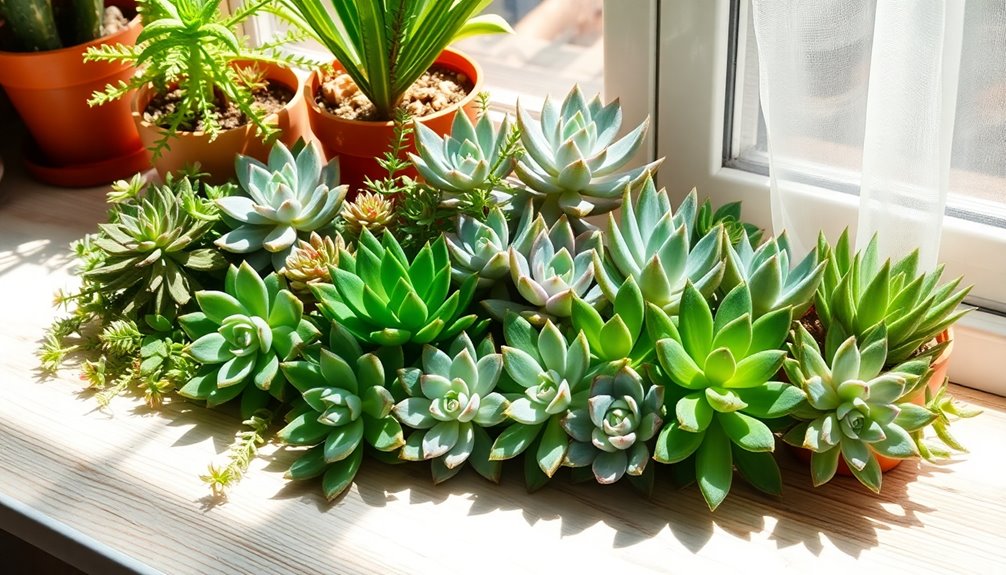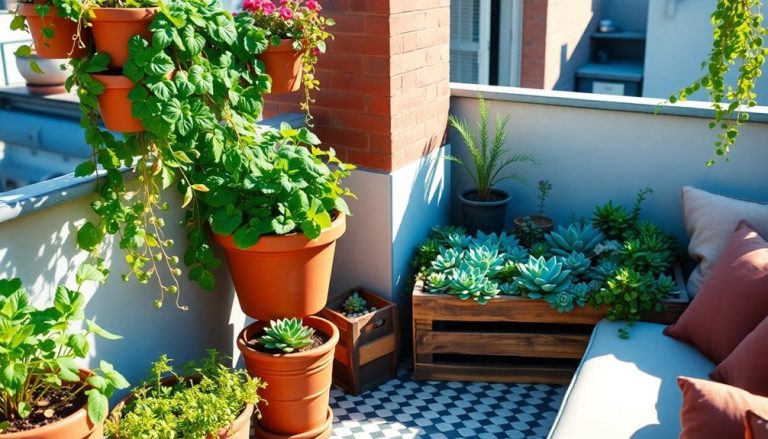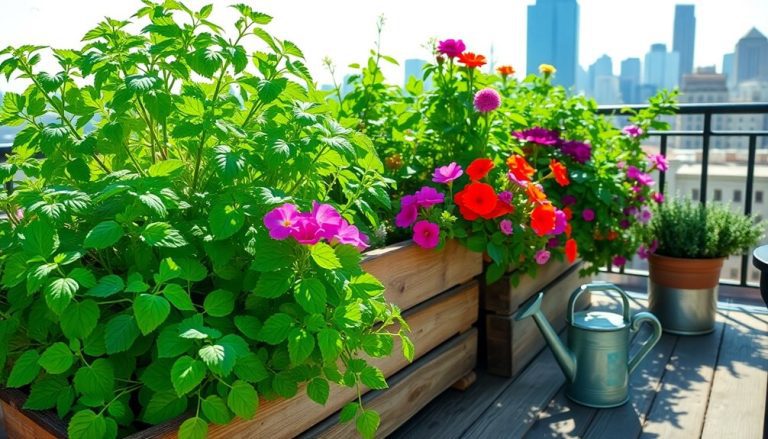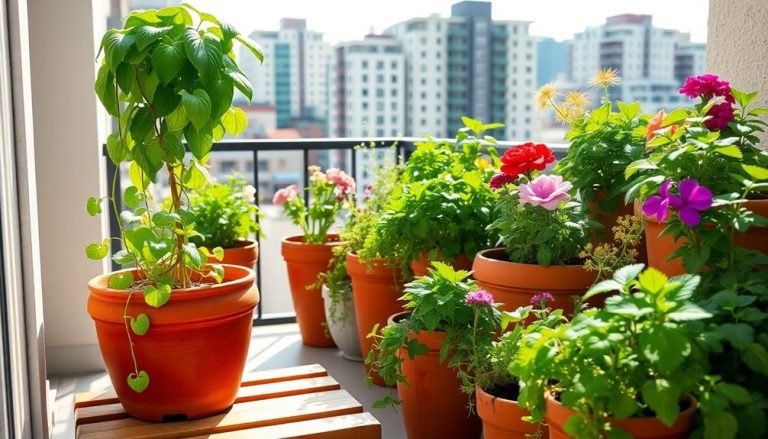Caring for indoor succulents means paying attention to their specific needs. Start by choosing pots with drainage holes and well-draining soil to prevent root rot. Place your plants in bright, indirect sunlight, rotating them every few weeks. Water only when the soil is dry, ensuring excess water drains away. Fertilize during the growing season at half strength, but skip in the fall and winter. Keep temperatures between 60°F and 80°F with low humidity. Regularly prune dead leaves and monitor for pests to maintain health. Interested in more tips to keep your succulents flourishing?
Key Takeaways
- Use well-draining soil and pots with drainage holes to prevent waterlogging and root rot.
- Provide bright, indirect sunlight and rotate plants for even light exposure.
- Water thoroughly but infrequently, allowing the soil to dry out between waterings.
- Fertilize during the growing season with diluted, water-soluble fertilizer for optimal nutrient absorption.
- Regularly prune dead leaves and monitor for pests to maintain plant health.
Choose the Right Pots
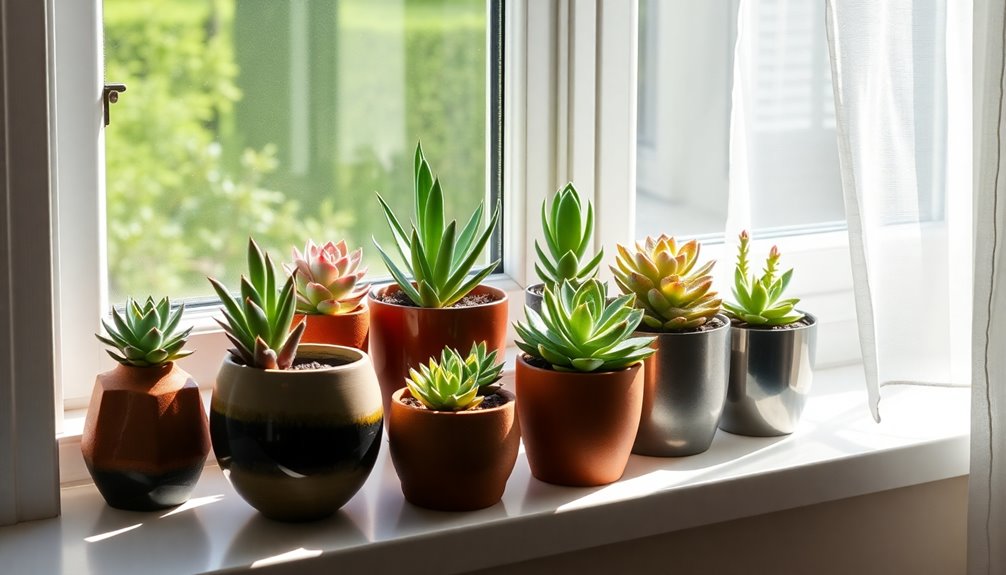
When selecting pots for your indoor succulents, prioritize drainage to prevent waterlogging. Succulents thrive in well-draining environments, so look for pots with drainage holes at the bottom. These holes allow excess water to escape, reducing the risk of root rot. Choosing the right pot can significantly improve your succulents' health and appearance, making it essential to consider the best plant pots available for your green space.
Terracotta pots are an excellent choice, as they're porous and help wick moisture away from the roots.
Next, consider the size of the pot. Make sure it's appropriately sized for your succulent; a pot that's too large can hold too much moisture, while one that's too small can stunt growth. As a rule of thumb, choose a pot about 1-2 inches larger in diameter than the plant itself.
You'll also want to think about the material. While ceramic and plastic pots can work, they don't always provide the same drainage benefits as terracotta. If you prefer a decorative touch, ensure that those pots have adequate drainage or use them as outer containers.
Lastly, always check for any cracks or damage before using a pot. A compromised pot can lead to further issues with moisture and stability. Additionally, choosing a pot that complements your home decor can enhance the overall aesthetic while promoting healthy succulent growth.
With the right pot, your indoor succulents will flourish!
Understand Light Requirements
Proper light is crucial for the health of your indoor succulents, as these plants thrive in bright, indirect sunlight. Place your succulents near a window where they can soak up the light without getting scorched. South-facing windows are often the best choice, as they provide the most consistent sunlight throughout the day.
If you notice your succulents stretching or leaning towards the light, it's a sign they need more exposure. Additionally, using a self-watering planter can help maintain consistent moisture levels, which is vital for their overall health.
On the flip side, too much direct sunlight can cause sunburn, leading to brown patches or shriveling. If you see these signs, consider moving your plants a few feet away from the window or using sheer curtains to diffuse the light.
Keep in mind that different species have varying light requirements. Some may thrive in lower light conditions, while others require more intense exposure. Research your specific succulent types to ensure you're meeting their needs.
Finally, rotate your plants every few weeks to promote even growth. This helps them receive balanced light on all sides, contributing to a healthier and more vibrant indoor garden. Additionally, using quality plant food online can support your succulents' overall health and growth.
Watering Techniques

Watering your indoor succulents requires a careful balance to prevent overwatering and underwatering. First, check the soil moisture before you water. Stick your finger about an inch into the soil; if it feels dry, it's time to water. If it's still moist, wait a few more days.
When you do water, make sure to soak the soil thoroughly. Water until it drains out of the bottom of the pot, ensuring that the roots get the moisture they need. Remember to empty any excess water from the saucer after watering, as standing water can lead to root rot. Using quality soil products can also enhance drainage and support healthier growth.
In general, succulents prefer to be on the drier side, so it's better to err on the side of underwatering.
During the growing season, which is typically spring and summer, you might water more frequently, about every two weeks. In the fall and winter, reduce watering to once a month or even less, as succulents enter a dormant phase. Additionally, using a well-draining soil mix is crucial for preventing root rot, as it helps excess moisture escape and keeps your succulents healthy.
Soil Selection
Choosing the right soil for your indoor succulents is just as important as mastering the watering technique. Succulents thrive in well-draining soil that allows excess water to escape quickly, preventing root rot. Regular potting soil retains too much moisture, so it's essential to select or create a mix specifically formulated for succulents.
When selecting soil, consider these key factors:
- Drainage: Look for a mix that includes perlite, pumice, or coarse sand to enhance drainage.
- pH Level: A slightly acidic to neutral pH (around 6.0 to 7.0) is ideal for most succulents.
- Organic Matter: Ensure the soil contains some organic material, like compost, to provide essential nutrients without retaining too much moisture. A good compost thermometer can help you monitor the temperature of your compost to ensure it's breaking down effectively.
- Texture: A gritty texture will help keep the soil loose, allowing air to reach the roots while preventing compaction.
You can also create your own blend by mixing potting soil with perlite and sand. This customization ensures your indoor succulents have the perfect environment to flourish, so keep an eye on your soil choices for the best results. Additionally, using a high-quality soil sifter can help you achieve the ideal texture and drainage for your succulent mix.
Fertilizing Your Succulents

Fertilizing your succulents can significantly boost their growth and overall health, but it's important to do it correctly. Start by choosing a balanced, water-soluble fertilizer specifically designed for succulents or cacti. Look for a formula with low nitrogen, as too much can harm your plants. Additionally, using fertilizer spreaders can help ensure even distribution of nutrients across your garden.
Apply fertilizer during the growing season, typically spring and summer, when your succulents are most active. Dilute the fertilizer to half the recommended strength to prevent over-fertilization, which can lead to root burn. You can fertilize your succulents every 4-6 weeks during this period.
It's best to fertilize after watering your plants. This helps ensure that the roots can absorb the nutrients without being overwhelmed. If you're unsure, skip a feeding; succulents are more tolerant of under-fertilizing than over-fertilizing.
In addition, consider using fertilizer tablets as they provide a consistent release of nutrients over time, making it easier to manage your succulents' feeding schedule. In the fall and winter, your succulents enter dormancy, so hold off on fertilizing during these months. This allows them to conserve energy and prepare for the next growing season.
Temperature and Humidity
Creating the right environment for your indoor succulents is crucial for their health, and temperature and humidity play significant roles in this. Succulents thrive in warm, dry conditions, so it's essential to maintain optimal levels for their growth.
Aim for a temperature range between 60°F and 80°F (15°C to 27°C). Keeping your succulents too cold or too hot can cause stress, leading to wilting or even death.
When it comes to humidity, succulents prefer low humidity levels, ideally around 30-50%. High humidity can lead to mold and root rot, which are harmful to your plants.
To create the best indoor environment for your succulents, consider these tips:
- Place them in bright, indirect sunlight to avoid sunburn.
- Avoid drafts from windows or air conditioning units that can affect temperature.
- Use a fan if your space is too humid to help circulate air.
- Monitor conditions regularly using a thermometer and hygrometer to ensure stability.
Pruning and Maintenance
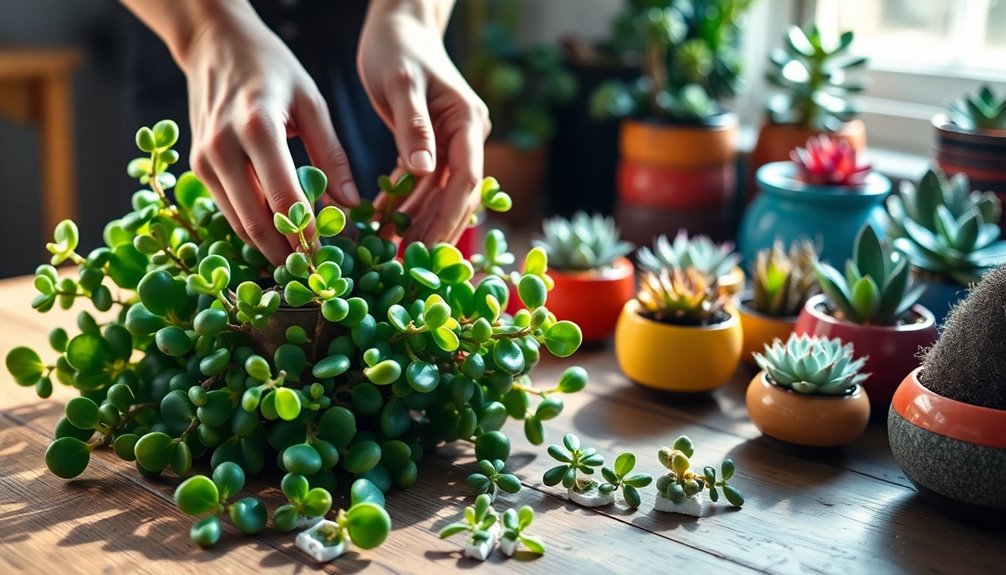
Regular pruning and maintenance are essential for keeping your indoor succulents healthy and vibrant. Start by removing any dead or yellowing leaves; this not only improves appearance but also prevents potential rot. Use clean, sharp scissors or pruning shears to make precise cuts, ensuring you're not damaging surrounding healthy foliage.
Next, assess the growth of your plants. If any succulents are becoming leggy or stretching toward the light, consider trimming them back. Cutting just above a leaf node encourages new growth and helps maintain a compact, attractive shape. Remember to prune during the growing season, typically spring or summer, when your plants are most resilient.
Additionally, don't forget about repotting. As your succulents grow, they may outgrow their containers. Choose a pot that's just slightly larger and refresh the soil to provide fresh nutrients. This is also a great opportunity to inspect the roots for any signs of rot or disease.
Lastly, keep an eye on the overall health of your plants. Regularly dust off the leaves to ensure they can photosynthesize efficiently. With consistent care, your indoor succulents will thrive beautifully.
Common Pests and Diseases
Even with diligent pruning and maintenance, indoor succulents can still face challenges from pests and diseases. You must stay vigilant to protect your plants from common threats that can hinder their growth.
Here are some of the most frequent issues you might encounter:
- Mealybugs: These small, white, cotton-like pests suck sap from your plants, leading to stunted growth and potential mold issues.
- Spider mites: Often found on the undersides of leaves, these tiny pests cause yellowing and webbing, which can be detrimental to your succulents.
- Fungal infections: Overwatering can lead to root rot or other fungal diseases. Ensure your plants have proper drainage to minimize this risk.
- Scale insects: These pests appear as small, brown bumps on the leaves and stems, and they can weaken your plant by feeding on its sap.
If you notice any signs of these pests or diseases, act quickly. Remove affected leaves, isolate the plant, and treat it with appropriate insecticides or fungicides.
Regularly inspect your succulents to maintain their health and beauty.
Repotting Succulents
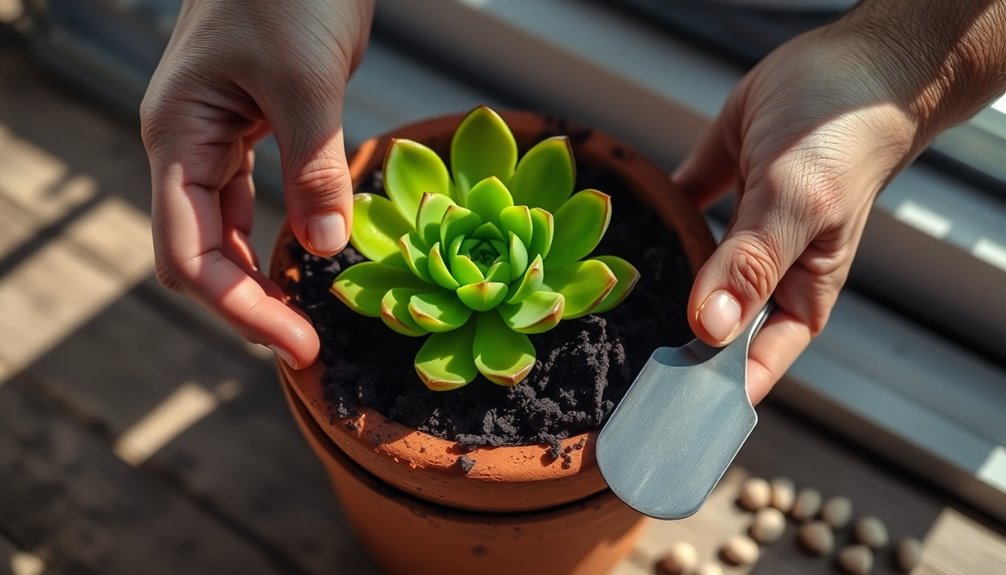
Repotting succulents is an essential part of keeping them healthy and thriving. You should consider repotting when your succulent outgrows its current pot or when the soil becomes compacted and loses its drainage ability.
Typically, you'll want to repot every couple of years or whenever you notice signs of stress, like stunted growth or yellowing leaves.
To repot, start by choosing a pot that's only slightly larger than the current one. Make sure it has drainage holes to prevent water from accumulating.
Gently remove your succulent from its pot, taking care not to damage the roots. Shake off excess soil and inspect the roots for any signs of rot. If you see any, trim them away with clean scissors.
Next, add fresh, well-draining soil—preferably a cactus mix—to the new pot. Place your succulent in the center and fill in around it with more soil, ensuring it's secure but not too tightly packed.
Water lightly after repotting, allowing the soil to settle. Finally, place your newly repotted succulent in a spot with indirect light. This way, you'll help it adjust and continue to flourish!
Frequently Asked Questions
How Do I Know if My Succulent Is Unhealthy?
To determine if your succulent's unhealthy, check for yellowing leaves, mushy stems, or signs of pests. If it's wilting despite proper watering and light, it might need immediate attention to restore its health.
Can I Group Different Types of Succulents Together?
Yes, you can group different succulents together, but ensure they have similar light and water needs. Mixing varieties creates an interesting display, just keep an eye on their health to prevent any issues.
Are Indoor Succulents Safe for Pets?
Indoor succulents aren't always safe for pets. While many are non-toxic, some can cause mild stomach issues if ingested. Always check specific varieties before bringing them home to ensure your furry friends stay safe.
How Often Should I Check for Pests?
Like a vigilant guardian, you should check for pests at least once a week. These tiny invaders can sneak up unexpectedly, so keeping an eye out helps protect your plants' health and vitality.
Can I Grow Succulents From Leaf Cuttings?
Yes, you can grow succulents from leaf cuttings. Just take a healthy leaf, let it callus for a few days, then place it on well-draining soil. Water it lightly, and watch it grow!
Conclusion
Caring for indoor succulents can feel like nurturing a tiny desert oasis in your home. Just like a well-tended garden thrives under attention, your succulents will flourish with the right pots, light, and care. Remember, they're resilient but need your support to thrive. Think of them as little green companions, quietly reminding you that even in the hustle of life, beauty can bloom with patience and love. So, embrace the journey and watch your plants thrive!

